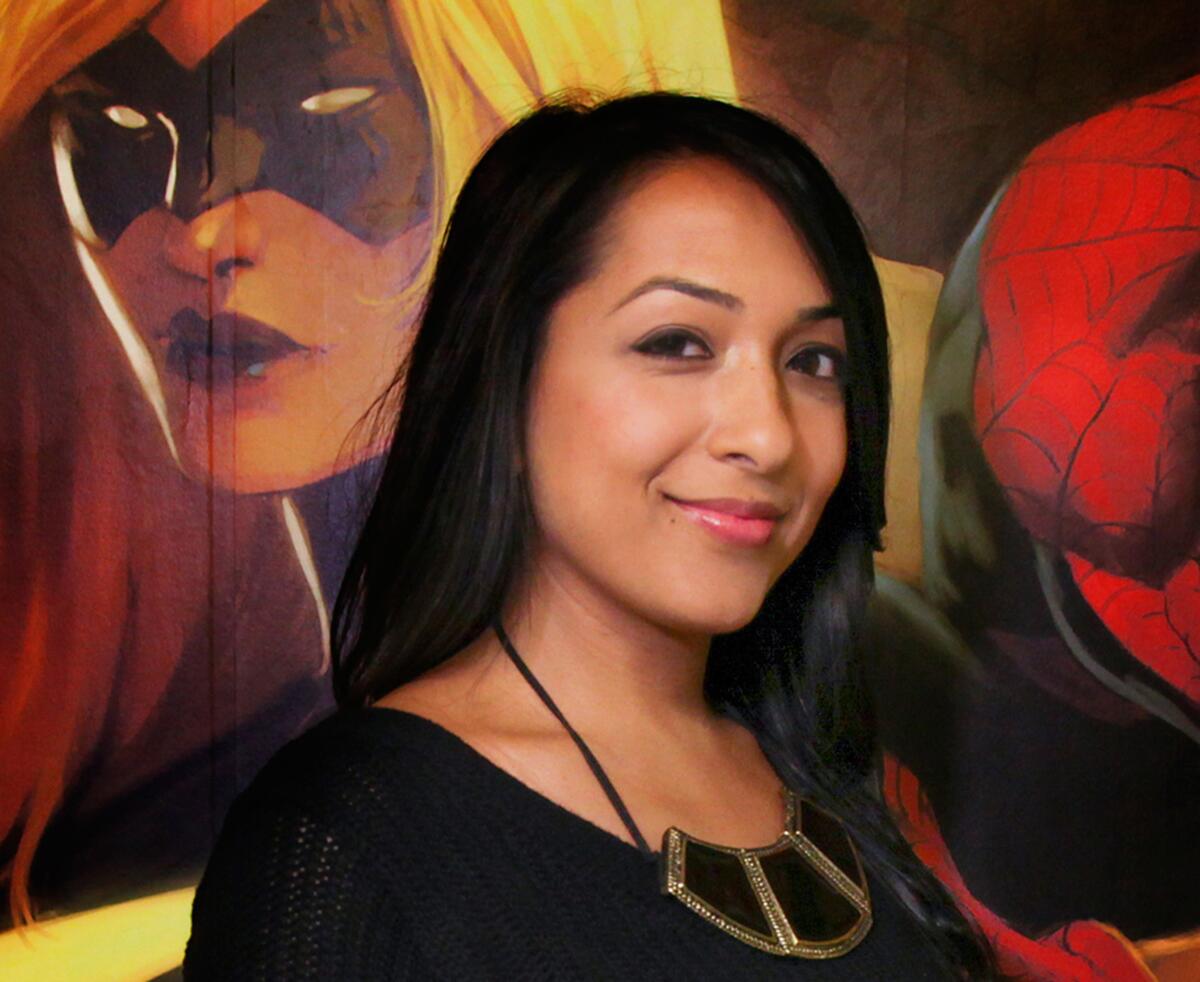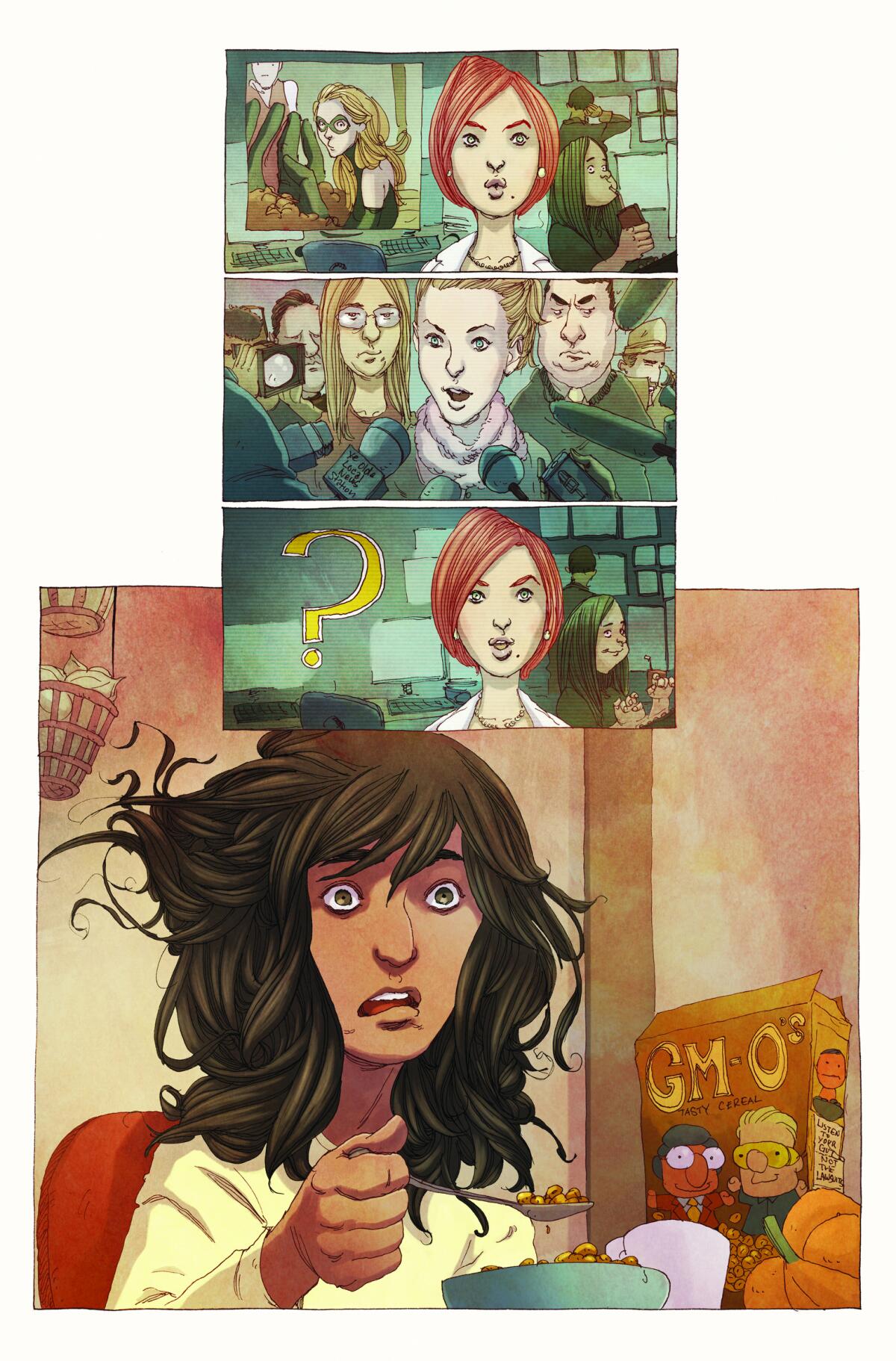‘Ms. Marvel’: G. Willow Wilson, Sana Amanat on Kamala Khan’s transformation

- Share via
The new Ms. Marvel was a media sensation months before her first adventure was published: Kamala Khan, the girl behind the superhero’s mask, would be Marvel’s first Muslim character to star in her own title.
But what shape her comic book series would take, and whether sales would match the hype, remained to be seen.
“People love to talk about new and different,” said “Ms. Marvel” writer G. Willow Wilson. “They don’t always love to buy and read new and different.”
The fear in debuting such a risky character, series editor Sana Amanat said, is always: “If we do something like this, is it a gimmick?”
As “Ms. Marvel” No. 1 heads to a third printing and this month’s No. 3 approaches, early indications are that the teenage Kamala’s story has resonated with readers — and drawn new customers into comic stores. The debut issue, released in February, sold out its first printing and finished in the top 25 of more than 400 titles on Diamond Comic Distributors’ chart of sales to comic shops for the month.
And Marvel said it was the publisher’s top digital comics seller last month, besting even issues of “All-New X-Men” and “Superior Spider-Man.”

At the center of the series’ story is 16-year-old Jersey City, N.J., Avengers fan fiction writer Kamala, a daughter of Pakistani Muslim immigrants who loves the smell of bacon — “delicious, delicious infidel meat,” she jokingly calls it — but abides by the rules of her faith and doesn’t eat it. She is an American, but has a different background than her classmates and struggles to find a sense of belonging.
“She’s awkward and unsure in terms of where she fits in and what she wants and who to believe about who she is,” said Amanat, who spearheaded the character’s creation with Wilson and series artist Adrian Alphona, by phone from the Marvel offices in New York. “I think those are conflicts that we can all connect with and we continue to connect with whether we’re teenagers, adults -- just kind of figuring out where we are in the world and what our place is and where we want to be.”
When a mysterious-to-her mist descends and empowers her with the ability to shape-shift, Kamala, who idolizes Captain Marvel, at first adopts Carol Danvers’ old Ms. Marvel moniker, her “classic, politically incorrect” old uniform — and her blond hair and lighter skin tone.
“It makes sense that at first she would think ‘Well, if I’m going to be a superhero, this is how I should look. This is how I’ve been told a superhero must look,’ ” said Wilson, on the phone from her home in Seattle in a separate interview, adding that the pressure young women feel to live up to unrealistic media images is more intense still for those of minority backgrounds.
The opening arc follows Kamala as she works to come to terms with her powers and herself. (“Being someone else isn’t liberating,” she says in Issue 2. “It’s exhausting.”)
Having a teenager struggling with identity become a shape-shifter has a certain metaphorical power. But it wasn’t obvious at the outset that morphing would be her superhuman ability.
“Her power set was actually the toughest thing, I think, to narrow down in the character creation process,” Wilson said. “I really did not want her to have the classically girly power sets -- I didn’t want her to float. I didn’t want her to sparkle. I didn’t want her to be able to read people’s minds. I think a lot of these sort of passive abilities are often given to female characters -- becoming invisible, using force fields. I wanted her to have something visually exciting, something kinetic.... The idea of making her a shape-shifter nicely paralleled her personal journey.”
But the writer notes that polymorphs in comics are most often shown as bad guys, a la the mutant villainess Mystique.
“It made sense that if we were going to attack one set of stereotypes, we might as well take on them all,” she said.
Alongside “Captain Marvel,” “She-Hulk,” “Black Widow” and the upcoming “Elektra,” “Ms. Marvel” is part of a wave of Marvel superheroine titles that are born of a growing, enthusiastic female comics readership, one that fills room after bigger room at boisterous Women of Marvel panels. Their stories are more character exploration, less exploitation.
“It’s not about the side boob,” Wilson said of “Ms. Marvel” and others. “It’s not about the tight costumes. It’s about real 21st century challenges and values that women have.”
Her and Alphona’s series was in for some expected heat upon announcement because of sometimes intense feelings about Islam in America, but it also was not going to be immune from criticism from Muslims.
Kamala’s family dynamics could have been a touchy issue, though each member is ultimately treated sympathetically. Her father complains that her devout brother is using religion to avoid getting a job; her mother too worries that Aamir will be a “penniless mullah.” And there’s Kamala’s curiosity about that forbidden bacon.
“I think people, especially in the Muslim community, are rightly cautious any time you hear ‘Oh, there’s going to be a Muslim character,’ ” said Wilson. “People’s guard immediately goes up because often what are portrayed in the media as ‘sympathetic’ characters end up rehashing the same stereotypes and racist baggage that all of the unsympathetic characters have reflected.”
But, she said, she and Amanat were confident that “when the book actually came out and people saw how the characters were represented in the series ... they would be reassured. That’s pretty much what happened.”
Kamala’s upbringing has much in common with Amanat’s. The editor is a Pakistani American Muslim who grew up in New Jersey. The character’s development started with her conversations with former senior editor Stephen Wacker, whom she credits with helping get the title approved at Marvel.
Amanat admired Wilson’s earlier work in both comics (the Eisner Award nominee “Air”) and novels (the World Fantasy Award-winning “Alif the Unseen”), and Wilson’s background -- she’s a white American raised without a religion who chose Islam as an adult, has lived in Egypt, is married to an Egyptian, and is the mother of two daughters with mixed backgrounds being raised as Muslims -- gave the writer a unique window into the character.
“She really understands so many different worlds because she lives in all of them,” Amanat said.
Not everyone is hooked on the new series just yet, however.
“My first review was from my 12-year-old nephew,” Amanat said. “He told me there was not enough fighting in Issue 1.”
More to Read
The biggest entertainment stories
Get our big stories about Hollywood, film, television, music, arts, culture and more right in your inbox as soon as they publish.
You may occasionally receive promotional content from the Los Angeles Times.










